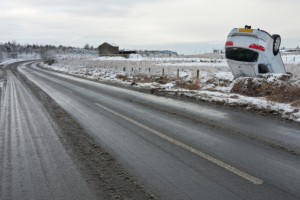Rollover Accidents Have High Fatality Rate

A well-regarded Oklahoma City firefighter was killed recently in a rollover accident on his way home after his shift. News reports quoted officials as saying he lost control of his truck near I-240 and Pennsylvanian Avenue. Wet pavement and rainy conditions likely contributed to the accident.
Rollover crashes have a higher fatality rate than many other types of auto accidents. Only 2.1% of all auto crashes in a recent year were rollovers, but they accounted for 7,600 deaths or 35% of all traffic fatalities, according to safecar.gov.
Speed often is involved in fatal rollover crashes. About 40% of fatal rollover accidents involve speeding. And 75% of those deaths are on roads with a speed limit at or above 55 mph.
Rollover accidents usually occur when a driver loses control of the vehicle. Often, rollovers take place just after a vehicle runs off the road. Such scenarios compound the danger due to uneven surfaces and other obstacles on the side of streets and highways.
Oklahoma residents need to be aware of the potential for rollover accidents on rural highways. About 75% of all rollovers take place on rural roads. Running off the road in the countryside is particularly dangerous because a vehicle can overturn when it hits a ditch or embankment.
Avoiding Rollovers
Losing control of a vehicle is frightening, but there are ways to avoid a rollover, even if the car has entered a slide or skid. The National Highway Traffic Safety Administration offers the following tips for avoiding rollover crashes:
- Do not over-steer. Panicked steering can cause drivers to overcorrect or turn too sharply, both of which can trigger a rollover crash.
Maneuver carefully. If possible, slow down gradually and regain control of the car. If the vehicle leaves the road, cautiously reenter traffic when it’s safe to do so. - Make sure tire pressure is adequate. Underinflated or overinflated tires do not have ideal traction, increasing the risk of loss of control on wet pavement and dry roads alike. Check the manufacturer’s recommendations on tire pressure and check and adjust the tire pressure regularly.
- Know the ideal weight distribution for the vehicle. The weight of passengers and cargo can shift the center of gravity within a passenger vehicle, and some arrangements can throw the entire car or truck off-balance. Do not carry too much weight, and make sure to distribute loads appropriately.
- Exercise caution on rural roads. In addition to the hazards addressed earlier, it is important to remember that emergency response times are longer in rural areas far from cities and towns.
Automobile safety technology and public awareness can reduce rollover accidents. Electronic stability control and antilock brakes are both helpful in regaining control of a vehicle that is sliding or skidding.
According to research by the National Highway Traffic Safety Administration, antilock brake systems help drivers avoid rollover accidents on wet and dry pavement. Since 2000, the NHTSA has released information about the rollover resistance of different models of passenger cars and trucks. The hope is that consumers will make informed decisions about whether a vehicle performs well in situations where a rollover might occur.
Blog CATEGORIES
Let's Talk About It
Speak with an experienced attorney at no cost to you

